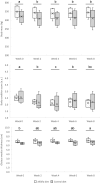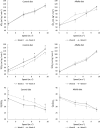Effect of high-starch or high-fibre diets on the energy metabolism and physical performance of horses during an 8-week training period
- PMID: 37745248
- PMCID: PMC10514361
- DOI: 10.3389/fphys.2023.1213032
Effect of high-starch or high-fibre diets on the energy metabolism and physical performance of horses during an 8-week training period
Abstract
Large amounts of high-starch concentrates are traditionally fed to horses in training. However, this has been associated with digestive or muscle diseases and behavioural modifications. In parallel, it has been demonstrated that horses fed high-fibre, low-starch diets achieve the same performance over an exercise test as the ones fed high-starch diets. However, whether the same performance level can be maintained over a longer training cycle is still being determined. This study aimed to compare the evolution in physical performance and cardiorespiratory responses of two groups of French Trotters fed either a control high-starch (15.0 g dry matter hay/kg body mass/day + 6.6 g dry matter oats/kg body mass/day) or a high-fibre diet (75% of oats replaced by dehydrated alfalfa) over an 8-week training period. The horses that entered the trial were untrained for ≥4 months and previously fed hay only. Track training with speed monitoring included interval training sessions and 2400 m performance tests from week 1 to week 8 (W8). Before (week 0, W0) and after (week 9, W9) the training period, horses performed an incremental continuous exercise test during which cardiorespiratory parameters were measured. Both groups progressed to the same extent regarding physical performance measured during interval training sessions (acceleration: 0.16 m.s-2 at W0 and 0.40 m.s-2 at W8; p < 0.0001), the 2400 m performance test (average speed: 8.88 m.s-1 at W0 and 10.55 m.s-1 at W8; p < 0.0001), and the incremental continuous exercise test (speed during the fastest stage: 9.57 m.s-1 at W0 and 10.53 m.s-1 at W9; p = 0.030). Although oxygen consumption increased with training (p = 0.071), it was not influenced by the diet. On the contrary, carbon dioxide production increased in the high-starch group only (high-starch group: 84.0 vs. high-fibre group: 77.7 mL.kg-1.min-1 at W9; p = 0.031). The results illustrate that horses in both groups progressed similarly but did not use the same metabolic pathways during exercise. This hypothesis is supported by carbohydrate oxidation, which tended to increase in the high-starch group at W9 but decreased in the high-fibre group (p = 0.061). In conclusion, the substitution of high-starch by high-fibre diets enabled similar performance over an 8-week training period and altered energy metabolism in a way that could be beneficial during high-intensity exercise.
Keywords: French Trotters; VܩCO2; VܩO2; alfalfa; gas exchange; incremental test.
Copyright © 2023 Martin, Lepers, Vasseur and Julliand.
Conflict of interest statement
The authors declare that the research was conducted in the absence of any commercial or financial relationships that could be construed as a potential conflict of interest.
Figures






Similar articles
-
A high-starch vs. high-fibre diet: effects on the gut environment of the different intestinal compartments of the horse digestive tract.BMC Vet Res. 2022 May 19;18(1):187. doi: 10.1186/s12917-022-03289-2. BMC Vet Res. 2022. PMID: 35590319 Free PMC article.
-
Exercise response, metabolism at rest and digestibility in athletic horses fed high-fat oats.Equine Vet J Suppl. 2006 Aug;(36):626-30. doi: 10.1111/j.2042-3306.2006.tb05616.x. Equine Vet J Suppl. 2006. PMID: 17402495
-
Effects on exercise metabolism of varying dietary starch and sugar proportions.Equine Vet J Suppl. 2002 Sep;(34):17-21. doi: 10.1111/j.2042-3306.2002.tb05385.x. Equine Vet J Suppl. 2002. PMID: 12405653
-
Gut health of horses: effects of high fibre vs high starch diet on histological and morphometrical parameters.BMC Vet Res. 2022 Sep 8;18(1):338. doi: 10.1186/s12917-022-03433-y. BMC Vet Res. 2022. PMID: 36076239 Free PMC article.
-
A forage-only diet alters the metabolic response of horses in training.Animal. 2012 Dec;6(12):1939-46. doi: 10.1017/S1751731112000948. Epub 2012 May 4. Animal. 2012. PMID: 22717208
Cited by
-
Fibrolytic efficiency of the large intestine microbiota may benefit running speed in French trotters: A pilot study.Physiol Rep. 2024 Nov;12(21):e70110. doi: 10.14814/phy2.70110. Physiol Rep. 2024. PMID: 39533164 Free PMC article.
References
-
- Arnaud G., Dubroeucq H., Rivot D. (1997). Notation de l’état corporel des chevaux de selle et de sport: guide pratique. Available at: https://books.google.fr/books?id=fzUvVzqv030C .
-
- Bulmer L., McBride S., Williams K., Murray J.-A. (2015). The effects of a high-starch or high-fibre diet on equine reactivity and handling behaviour. Appl. Animal Behav. Sci. 165, 95–102. 10.1016/j.applanim.2015.01.008 - DOI
LinkOut - more resources
Full Text Sources
Miscellaneous

